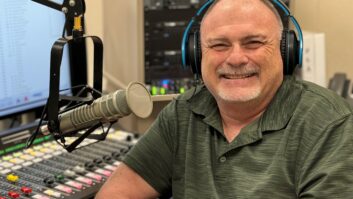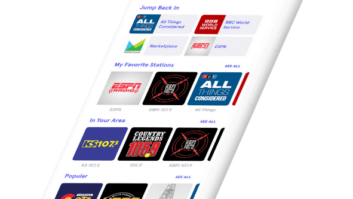The following interview appeared in the recent Radio World eBook “AM Translators: What’s Next?”

Cal Zethmayr is general sales manager of 100 kW WAAZ(FM) and 5 kW WJSB(AM) serving northwest Florida and south Alabama, and host of “The Z-Files” program. An active ham radio operator, W4GMH, he earned his first license in 1953 and his FCC First Phone the next year.
Radio World: Tell us briefly about WAAZ and WJSB.
Cal Zethmayr: Both stations are owned by Crestview Broadcasting Company Inc. James T. “Jimmy” Whitaker built WJSB(AM) on 1490 with 250 watts when he was 19 years old in 1954. The call letters stood for Jimmy; Sheldon Henderson, his stepfather; and Betty Kennedy Whitaker, his bride.
WAAZ(FM) went on the air in 1964 as a 3 kW on 104.9 and then later moved to 104.7 with 30 kW. In 2000 it went up on a taller tower with 100 kW.
Our area has a unique situation. Because of our proximity to the very large Eglin Air Force Base, no tower can be built that is over 500 feet above ground. We are one of three C1s but cannot have a 2,000-foot tower! Our advantage is we are at 206 feet above sea level; all of the other stations in our county are grouped in a three-block area of Fort Walton Beach at 14 feet above sea level and also less than a mile from the Gulf of Mexico. Not a lot of commuters going home from work travel south!
WJSB went through power and frequency changes over the years, first up to 1 kW on 1490, then a change to 1050 1 kW, then 5 kW. When a rebuilt 10-bay ERI antenna and a new taller (466-foot) tower were installed for the upgrade to 100 kW at WAAZ, the WJSB AM transmitter output had to be reduced to 3.1 kW, but now it’s on a half-wave tower.

Cal Zethmayr
RW: Why is the station pursuing plans for a translator for the AM?
Zethmayr: In 1993, Crestview, Fla., was “blessed” with the first Walmart Supercenter store in Florida. One year later, WCNU(AM) went out of business; one of the two local newspapers folded and the name was merged with the survivor.
WAAZ(FM) and WJSB(AM) went from 14 employees to four in that one-year span. A rather clunky automation system using a DOS 386 computer and four CD changers that had a capacity of 250 CDs were installed.
Why did WAAZ/WJSB lose 10 employees? About $25,000 a month of local advertisers were out of business. And WJSB(AM), a daytimer, began simulcasting WAAZ(FM). Many people who listen to us at night think they are hearing WSJB.
Shortly after becoming GSM, my job description was “sell the ads, get the spots on the air and whatever else needs to be done.” I quickly discovered some unhappy advertisers who complained about the CDs playing the music being cut off mid-song twice an hour when the system switched to CBS. A broadcast friend introduced me to a low-cost software program created in New Zealand. It was in its early stages. I became one of a group of “alpha testers,” and once the old DOS PC began to break down we put this software, StationPlaylist Creator, on the air. It works great and I’ll use it to program the new WJSB(AM) format and its associated translator.
With a translator that I hope will cover all of the highway that travels north and south through our county, and which has 56,000 vehicles every 24 hours using it, I will be able to create different programming and of course a source of new revenue.
By the way, Interstate 10 travels east and west through the south end of Crestview, and averages about 25,000 vehicles per 24 hours.
Zethmayr used this map to explain translator scenarios. The Gulf of Mexico is at very bottom; the large area outlined by a dark blue line, lower center, is Eglin AFB. The largest light blue circle is the 60 dB for WAAZ(FM); the light blue circle inside it is the 0.5 mV/m signal of WJSB(AM). The purple is the WJSB(AM) FCC defined 2 mV/m, and the lighter blue circle just inside that is the FCC calculated 60 dB for the translator, based on a non-directional antenna at the top of the company’s 466-foot tower. The yellow line running south from center is Florida Highway 85; the magenta line running generally north is another highway, busy in summer. The red semicircle with flat side is Zethmayr’s “dream” translator coverage; the small gold one with flat side is his “compromise” coverage. He has yet to determine if a directional antenna is needed. Under current tower siting rules, a translator can reach out to the 25-mile circle, the one in red with possible flat side to the northwest to prevent interference to a station 100 km away. Although WAAZ(FM) is a C1, it cannot have a tower that exceeds 500 feet, nor can any station in this part of Florida because of the military presence.
Click to Enlarge

RW: What important steps lie ahead for you in the process of building this?
Zethmayr: I attended the Radio Show in Austin. I talked with all the equipment folks, especially the antenna manufacturers. I feel we will need to use a directional antenna. Our extra 200 feet above sea level is going to be a benefit to hopefully get our signal out close to the 25-mile FCC limit.
I listened closely to the comments by Peter Doyle, Audio Division chief of the Media Bureau. Of the 1,081 applications filed in the one-week August 2012 window, 826 of us are singletons. I think it’s amazing that there are only 261 “mutually exclusive” apps. In our area of northwest Florida, all of the AMs that filed are singletons.
Our consultant, Bob du Treil Jr., gave us a list of frequencies; Mr. Whitaker and I did a lot of listening on all of them. I traveled around the area quite a bit. I put the data on the stations on all of the frequencies into a spreadsheet; and we think our choice was the best one to give us the best coverage and least interference from other stations on the frequency or adjacent.
Some of the frequencies on Bob’s list were applied for by other stations in our area that would have made us compete via the mutually exclusive process.
RW: Are AM broadcasters finding success with translators financially?
Zethmayr: I only know the info I read in the magazines and online newsletters. I don’t have any financial info from those who put translators on the air last year.
I do notice when listening to stations when I travel — in Florida, Alabama, Georgia — that the AM frequency rarely gets mentioned. I have heard some where the FM frequency and/or station image phrase is all that is given.
I have done my own very conservative projections on potential new revenue, and I am talking to my accounts to get their reactions to possible formats. I’m going to do some survey work to get a better feel from the general public. We have a website, I have a YouTube Channel and a Facebook presence. I publish a weekly Z-FILES newsletter every Friday with a very large subscription list and way above the national average of percentage of opens and clicks.
I will use these ways to contact these readers/viewers to engage them in participating in an online survey. And we will promote that on the air, telling our current listeners that we are adding a new radio frequency and asking for their opinions.
I looked at some of the survey companies at the Austin meeting and also some of the online survey providers. Haven’t made a final decision on which to use.
RW: What’s the most interesting experience you’ve had with a translator?
Zethmayr: Last year I checked the applications data on the FCC Daily Digest and looked at the prices that a “piece of paper” — a CP or license — cost. We knew that was way out of our budget. Now I am in the equipment-pricing mode. And the most difficult part is going to be getting our translator’s one-bay antenna high on our tower, considering there is a 10-bay with 100 kW up there.
RW: What else should people interested in this topic know?
Zethmayr: Have a good relationship with your consultant, get info from the equipment people, hope you can get a tower crew when it comes time to install your antenna.
I read in the industry publications — and since Mr. Whitaker is in the cell tower business, I also see that industry’s magazines — that the TV repacking is going to make it a challenge to get tower crews.
Both of our transmitters are here in our office/studio building. We won’t need to deal with STL or remote control costs.
A new translator owner will have to decide if they are going to expand what they are already programming on the AM, or if they want to reach a different audience [with both].










